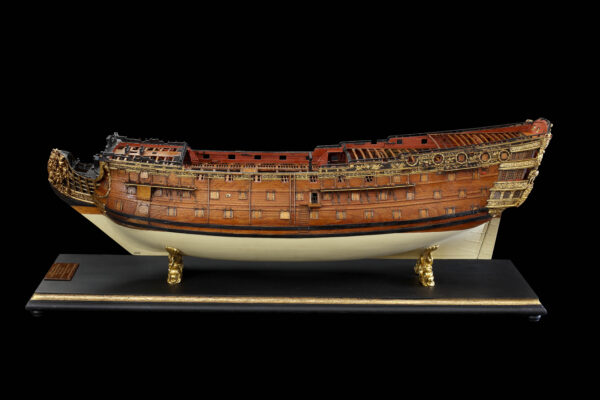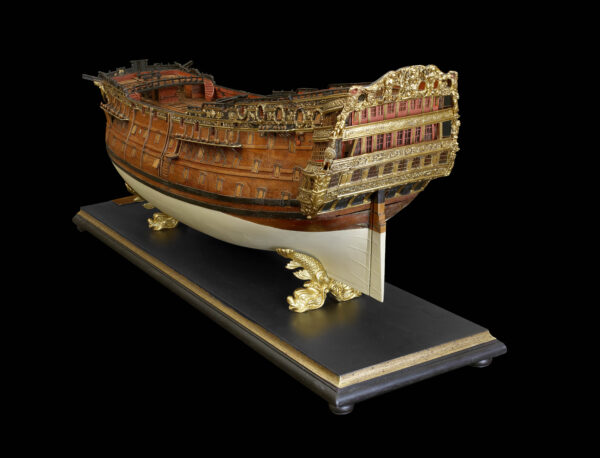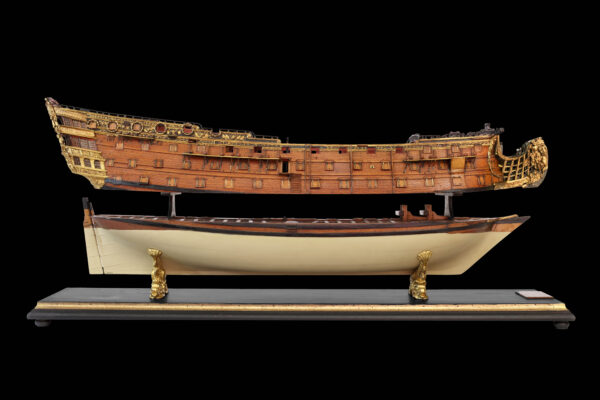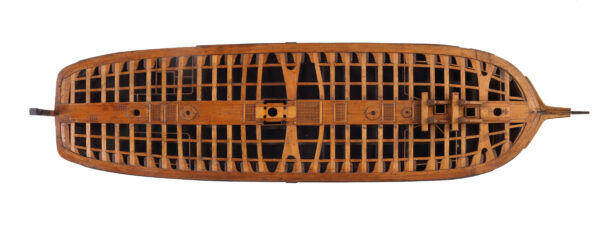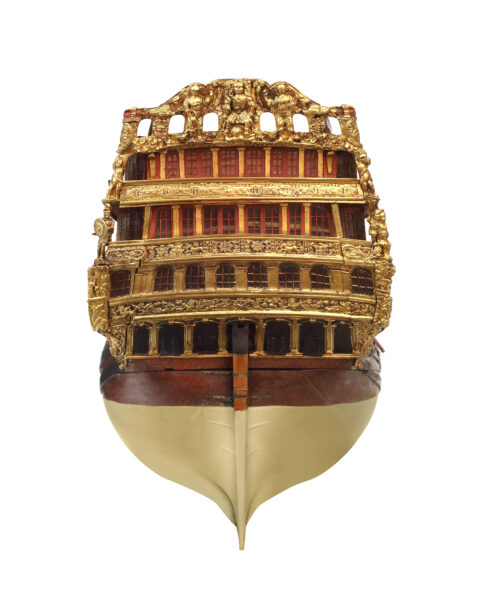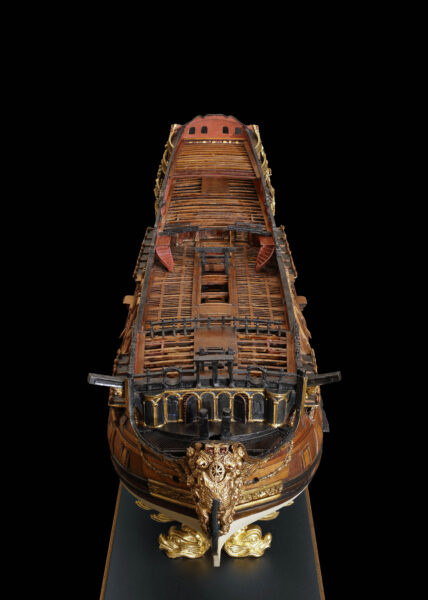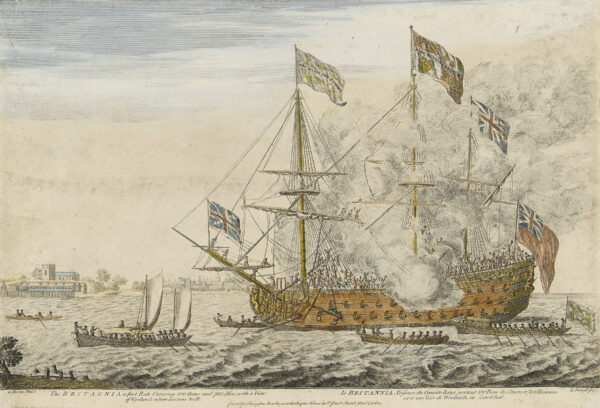A Curious Model of the Britannia, a Ship of 100 guns
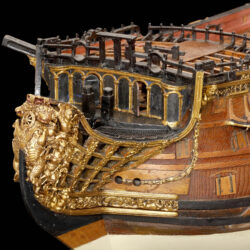
The Admiralty ‘Pull-Apart’ model for the First Rate Ship of the Line Britannia, scale 1:48.
Workshop of John Hayward, Master Shipwright at Woolwich Dockyard, circa 1715.
A contemporary dockyard model fully decked, equipped, and made to separate at the gun deck, revealing the deck beams.
Mounted on a later baseboard with plaque inscribed: ‘The Worshipful Company of Shipwrights presented by Walter Leslie Viscount Runciman of Doxford Prime Warden 1940. In memory of his father Walter Viscount Runciman of Doxford, PC prime warden 1926’.
Yellow Pine, box and frutiwoods. English, circa 1715.
Overall model size approx: H.430 x L. 1400 x W. 310 mm/ 18 x 48 x 8 inches.
Provenance:
Probably Sir Henry Johnson of Blackwall Dockyard (c.1659-1719).
1 November 1722: ‛To be Sold by Auction The Collection of Mr. Robert Dicks…a Large and Fine Model of the Britannia, lately belonging to the famous Collection of Sir Henry Johnson’.
1744: ‛At Pinchbeck’s Repository…A Curious Model of the Britannia, a Ship of 100 guns’.
Before 1919: Collection of Sir Walter Runciman Bt. (1847-1937), later Viscount Runciman of Doxford.
1937: By descent to his son Walter, Viscount Runciman of Doxford (1870-1949).
1940: By his gift to The Worshipful Company of Shipwrights, London.
Published:
1919: Sir Walter Runciman Bt.: ‛Drake, Nelson and Napoleon’ (London, 1919), as the frontispiece.
Exhibited:
23 July – 17 October 1982: ‛Shipbuilding on the Thames’ at the Museum of London.
1950-2021: On loan to the National Maritime Museum, Greenwich where on public display in the Maritime London Gallery.
Britannia was a 100 gun first rate ship of the line built by Phineas Pett II at Chatham Dockyard and originally launched on 27 June 1682. On 19 May 1692 it was the flagship of Admiral of the Fleet Edward Russell, Earl of Orford at the Battle of Barfleur when an Anglo-Dutch fleet defeated a French attempt to restore James II to the throne. In 1715, Britannia was ordered to be taken to pieces and rebuilt at Woolwich Dockyard under direction of the shipwright John Hayward: ‛to the dimensions of the Soveraigne, viz. 174ft 6in. x 50ft x 19ft 10in. 1,882 tons’. The following year, the Admiralty ordered that a model be made for every new or rebuilt ship. However, it appears the work on Britannia was completed before revised Admiralty rules for warship construction were fully implemented in 1719. These specified more restrained (cheaper) decoration for ships of the line, but Britannia retained seventeenth century style circular port wreaths on the quarterdeck and elaborate carvings on the stern and gunwhale. These include, on the taffrail, figures representing the new Hanoverian King George, crowned in 1714, seated in majesty between Asclepius, god of healing powers, and Justitia, the personification of justice. The king’s feet rest on a merman, symbolising his command of the seas. Royal power is further emphasised by the repeated use, on the stern and gunwhales, of the star badge of the Order of the Garter, and representations of the Hanoverian White Horse, the heraldic symbol of the new reign. The figurehead is similarly centred on the Order of the Garter between crowned sea lions supported by figures symbolising peace and plenty.

Scale: 1:48. Plan showing the body plan, sheer lines with some external detail, and longitudinal half-breadth for Britannia (1719), a 1719 Establishment 100-gun First Rate, three-decker. The plan is undated, but she underwent some refitting and later surveys during her lifetime.© National Maritime Museum, Greenwich, London. Object: ZAZ0118
The cost of rebuilding Britannia was £29,393. 10.1d. Launched again on 30 October 1719, during a long period of peace, Britannia was not commissioned for service until 1734 when the ship was carried the flag for Admiral Sir John Norris (1670-1749) and was ordered to the Tagus to protect Portugal from Spanish attack. Norris was painted by George Knapton the same year with Britannia in the background wearing his new flag as Admiral of the Fleet. Later, Britannia was converted to a hospital ship before finally being broken up in 1750.
The model of Britannia probably belonged to Sir Henry Johnson II (c.1659-1719), Member of Parliament and owner of Blackwall Dockyard on the Thames. Originally constructed for the East India Company, the dockyard had been purchased in the 1660’s by Johnson’s shipwright father Sir Henry Johnson I (1623-1683). So successful was the dockyard that, upon inheriting it, Sir Henry was said, by his father’s friend Samuel Pepys, to be ‘above all personal labour, too well provided for to work much’.[1] Preferring politics to ship building, and following a second marriage to the heiress Martha, Baroness Lovelace, Henry left the management of the yard to his younger brother William Johnson (c.1660-1718), a merchant and former factor to the East India Company in Bengal. Between 1704 and 1710, William built five ships of the line and six other vessels at Blackwall. He resided within the dockyard in a mansion built by his father in the late 1670’s, luxuriously furnished and decorated with murals depicting battles and models of ships built at the yard. A large portrait of Royal Prince, built by Phineas Pett at Woolwich in 1610, adorned one mantel-piece, while a second was decorated with a portrait of the Sovereign of the Seas launched from the same yard in 1637.[2] It was within these opulent surroundings that Henry Johnson I was knighted by Charles I in 1679 and this model of Britannia was originally displayed.
Like their father, both the Johnson brothers owned ship models which they acquired as ship builders but also as collectors. In 1684, Samuel Pepys recorded:
That two models of Mr Phinas Pett of Woolwich, one of the Captain, and the other he thinks of the Grafton…did stand at Garraway’s to be sold three weeks for public sale and were sold, one to Mr Upton for £12…and the other to Mr H. Johnson (Sir H. Johnson’s son) for £20. He bought them of Mr Pett’s kinsman that lives at the Anchor in Lombard Street.[3]
The exact use of early ship models is debated. Presumed to serve a functional purpose in the commission of ships of the line by the Board of the Admiralty, the best examples were sought after as high status artworks, and crafted as such.
The Johnson brothers died within months of each other: William at Guinea in 1718―to which he had been fatally tempted by the profits of the slave trade―and Henry the following year. After William’s death, the contents of the Johnson mansion at Blackwall were removed and taken to his town house in Surrey Street on the Strand to be sold off by auction. Among the various ‛Silk Beds and Bedding‛, ‛fine China Ware’ and ’India Japan Goods‛ offered for sale, were ’Models of several Ships‛.[4]
The model of Britannia may have been among them as just four years later in 1722: ’a Large and Fine Model of the Britannia, lately belonging to the famous Collection of Sir Henry Johnson’ was offered for sale from the deceased estate of Robert Dicks ‛Jeweller and Virtuoso ‛on the premises at the sign of ’Two Twisted Poles’ in Long Acre at James Street, Covent Garden.[5]
Twenty years later in December 1744, ‛A Curious Model of the Britannia, a Ship of 100 guns‛―likely the same model and now in a glass case―was offered for sale again, at Pinchbecks Repository in Pall Mall.
Thereafter, and for almost two hundred years, the model of Britannia cannot be traced. A ‛curious Model of a 100 gun Ship’ was advertised for sale by auction in 1814, and again in 1817 but firm attribution is impossible. Identification of the model, like so many others, was likely lost after Britannia was broken up in 1750 and living memory of the ship faded. The model was not identified by name at the time of its gift to the Worshipful Company of Shipwrights by Viscount Runciman in 1940.
A 1934 newspaper report on Runciman’s collection of ship models―then on display at Doxford Hall, his property in Northumberland―identified his ‘most valuable’ model as ‘a full working model to scale, very large, of the Royal Charles a three-decker built in the late 17th century’.[6] Untraced, this model may, in fact, have been Britannia. In 1950, following Runciman’s death, an unspecified number of his ‛Models of Ships’ were dispersed by auction at Doxford[7]. The Worshipful Company of Shipwrights also loaned their model to the National Maritime Museum where it was formally re-identified as Britannia using the museum’s contemporary Admiralty 1:48 technical plan of the ship[8], and by comparison with a print after Thomas Baston’s drawing of Britannia at Woolwich published in 1719.[9]
Ship models of the early 18th century are rare with those examples designed to separate at the lower gun deck, known as pull-aparts, exceptionally so. In addition to Britannia, only four other such models are known: the Third Rates Royal Oak (Kriegstein Collection, USA) and Revenge (The Thomson Collection at the Art Gallery of Ontario); and the First Rates Royal William (National Maritime Museum, Greenwich) and Royal George (University of Göttingen). With the exception of Royal William, all these ships were rebuilt at Woolwich Dockyard before 1719 suggesting their models were crafted in the same workshop under direction of of John Hayward, appointed master shipwright at the dockyard in 1715. The models of Royal Oak and Royal George can both be traced to the royal collection—Royal Oak by 1816 and Royal George before 1744[10]—and Royal William to First Sea Lord Admiral Earl St Vincent (1735-1823) providing further evidence that such models were considered especially high status.
[1] Cited in J.Ehrman, The Navy in the War of William III 16891697, 1953, p.75.
[2] Chronicles of Blackwall Yard, I, 17. This painting was subsequently in the collection at Trinity House, see “The Royal Sovereign of 1637 Part I”, Mariners Mirror, April 1913.
[3] Chappell, E., The Tangier Papers of Samuel Pepys, (Navy Records Society, 1935), 324; quoted in Ball, N. & Stephens, S. Navy Board Ship Models (National Maritime Museum, 2018). 33. The model of Grafton might be identified as the Navy Board style model of Grafton, 70 guns, built in 1679 formerly belonging to Charles Sergison and now in the Rogers Collection at the U.S. Naval Academy, Annapolis, USA.
[4] “Advertisements and Notices.” Post Boy, February 7, 1719 – February 10, 1719
[5]“Advertisements and Notices.” Daily Post, 31 Oct. 1722
[6] Sunderland Echo and Shipping Gazette, 27 February 1934, page 3.
[7] The Berwick Advertiser, 7 September 1950, page 2.
[8] NMM ZAZ0118
[9] NMM PAG6959
[10] Royal George was a gift from the Prince of Wales to the University of Göttingen in 1744, http://www.universitaetssammlungen.de/modell/2?setLocale=en
